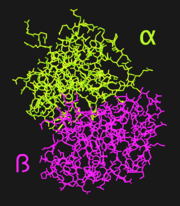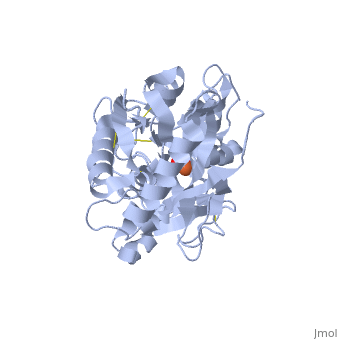Amino-Terminal Half-Molecule of Human Lactoferrin
Human lactoferrin, LF, is a protein in the transferrin family. As such, it has the ability to tightly bind iron in conjunction with a large-scale conformational change associated with iron binding and release.[1] These properties give lactoferrin the ability to regulate iron, and possibly other metal, ion levels in the fluids and secretions, such as milk, of animals.[1] Lactoferrin is folded into two lobes: the N-terminal half, LFN (1dsn), and the C-terminal half, LFC. The two LF lobes have 37% homology and very similar tertiary structures; it has been suggested that the two lobes are the product of gene duplication.[2] Each lobe of LFN is further subdivided into two similarly sized α and β domains (Figure 1); the is situated in a deep cleft between the two domains.[1]
In humans, lactoferrin is most abundant in milk, where it acts as part of the innate immune system.[3]
Structure

Figure 1. Cartoon illustrating the alpha (green) and beta (magenta) domains of LF
N The amino-terminal half-molecule of human lactoferrin (LFN) is comprised of a single 333 amino acid chain divided into two similarly-sized α and β domains. The iron binding site is located within a deep cleft between the lobes, where iron is bound by of the α and β domains, respectively. Iron, which is bound to a carboxylate ion, is bound by Asp60, Ala123, and Gly124. Although unwound in LFN, form a helix when joined to LFC, forming the full LF protein.[1]
The structure of LFN undergoes a dramatic conformational change upon iron binding. Upon iron binding, the two domains of LFN undergo a rigid 54.1º rotation about a that passes through Thr90 and Pro251.[4]
To visualize the , we first load the two structures and superimpose them. You can choose a viewing orientation before pressing the morph button, which will visualize the conformational change from structure 1CB6 to 1LCF and back again[5]
.
Function & Application
Like transferrin, lactoferrin is an iron binding molecule, capable of regulating iron levels in bodily fluids and secretions.[1] Unlike transferrin, only trace amounts of lactoferrin are found serum; however, lactoferrin can be found on concentrations ranging from 1 g/L to 7 g/L in milk.[3] In human milk, lactoferrin is a part of the innate immune system, demonstrating anti-microbial properties.[3][2] Many of lactoferrin's anti-microbial effects come from its ability to sequester iron, necessary for microbial growth.[2] Lactoferrin also exhibits anti-viral activity by binding to the key viral features of several viruses including hepatitis c virus, rotavirus, poliovirus, and HIV.[6]
Because of the intrinsic antiviral properties of lactoferrin, it is of great interest as a drug delivery molecule. In this system, traditional antiviral medication, that can normally lead to a wide range of side-effects, can be targeted using lactoferrin, mitigating any ill effects.[6]
External Resources
Lactoferrin at Wikipedia
3D structures of human lactoferrin
Lactoferrin


